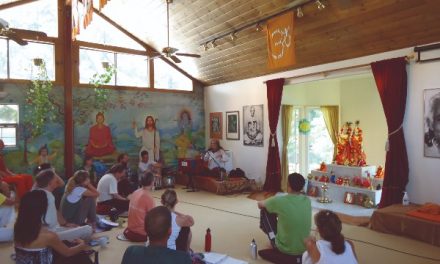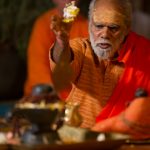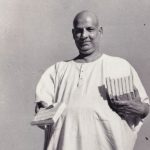 How to Love without Attachment
How to Love without Attachment
By Swami Swaroopananda
Question: What is detachment and how do we love with detachment?
Answer: Detachment means detachment from suffering and the causes of suffering. This is one of the great teachings in yoga. Long before Lord Buddha taught that was life suffering, the yogis taught about samsara – that mode of existence that is nothing but suffering. We are born, we live, and we die.Actually, the yogis said that in between death and the next life, there is also another type of existence – so, birth, life, death, existence after death, and again birth. It is a cycle we repeat, again and again. This cycle of birth and death is called samsara. The yogis said that samsara is full of pain.
 Now, you may say, “Nah, Swami, this is not true.” Why do you say this? Because it is true that in our lives we experience pain, but we also experience pleasure. So you think, “These yogis must have been mistaken. Because they say samsara is full of pain, but my own direct experience shows me otherwise, that life is not only pain, there is also pleasure.”
Now, you may say, “Nah, Swami, this is not true.” Why do you say this? Because it is true that in our lives we experience pain, but we also experience pleasure. So you think, “These yogis must have been mistaken. Because they say samsara is full of pain, but my own direct experience shows me otherwise, that life is not only pain, there is also pleasure.”
For example, today is a beautiful day; it is very pleasurable. Another day it may be cold, less pleasurable, (unless you like cold!!) But the yogis proved, beyond any doubt, that indeed even when we experience pleasure, this pleasure is masked pain. Let us see how.
Desire
The main cause of pain is what we call karma. And the main cause of karma is what we call desire. Desire has two forms. One we call raga, which is attraction to what is pleasurable. The other type of desire is called dvesha, aversion toward the painful.
These are the two types of desires, and they are what push us to act. Either you see something you desire and you act in order to possess or experience it or you see something that you think is painful, and you take action to escape or avoid it. Those actions are called karma, and they are respon – sible for samsara, the cycle of birth and death.
Try to find one thing that does not fly away, including this body, including beauty, including youth, including intelligence, including wealth. Do not get attached to things that fly away, which is all things. You are going to suffer.
Karma can only yield two types of fruit: sweet or bitter, in other words, pleasure or pain. Now, nobody has to convince us that pain is suffering. This is clear. How, though, is pleasure also the source of pain? Because of our desire for, and attachment to, the pleasure. The desire that I am talking about is called raga-dvesha.
This is what we call attachment, attachment to the pleasurable and attachment to, in the form of aversion, the un-pleasurable. This attachment, in a manner of speaking, is the direct cause of karma. And karma, in a manner of speaking, is the direct cause of samsara. And samsara, in a manner of speaking, is nothing but misery. Let us look deeper.
The Cause of Suffering
Yogis identified this problem long ago and asked themselves the question, “What is the cause of samsara? What is the cause of attachment? What is the cause of karma? What is the cause of suffering?” If you know the cause, you are on your way to find the remedy. The yogis found that the cause of samsara is ignorance. They called it spiritual ignorance, or avidya. They said that the reason we suffer is because we have the wrong type of knowledge about reality.
It is not just that we don’t know what reality is, since not knowing is not too bad. It is an actual misapprehension of reality; we do not know reality for what it actually is. The classical example that is given is of the rope and the snake: a person at twilight sees a rope and thinks that the rope is a snake. Due to ignorance of the fact that it is a rope, there is a misapprehension that takes the shape of a non-existing snake, an illusory snake, causing fear. This is the same misapprehension we have about the nature of reality.
Not being attached means being free, being able to love. In love, there is no fear. In real love, there is no fear. In attachment, there is fear of loss. There is always fear of loss in attachment. Not so in love.
Attachments
Now think about it. Tonight, before you go to sleep, take a note – book and write a list of all of your attachments. Maybe there will be 10, maybe 100. Maybe there will be 2,000 of them. Maybe you have to spend the whole night writing. Then, look at all of these attachments, and ask yourself, “How many more attach – ments would I like to have?” “I have 2,000. Would I like to have 2,000 and one?” Does anyone think, “I have 2000 attachments; that is not enough!?”
Does anyone think one attachment is happiness, two attachments is greater happiness, and 2,000 attachments is ecstatic happiness? Write down your attachments, and sincerely ask this question: “Do I want more?” If we are sincere, the reality is that each attachment is like a shackle; we are shackled in chains. Not one chain – thousands and thousands and thousands of chains. We are imprisoned in chains of attachments, which bring suffering. Why?
Change
You may desire whatever you like; it does not mean that you are going to get it. This alone can cause suffering. The more important thing is that even if you get what you want, it is guaranteed that you are going to lose it. Ultimately, everything changes, things that come will go, and eventually, everything will go away. So again, let us say that I am attached to, I have a desire for, an object. The likelihood that I am going to possess the object is not very high, and so I will suffer greatly.
Let us say, however, that I do obtain it. Once I possess the object, there might be a moment of pleasure, but, and this is the key, the likelihood of that pleasure lasting very long is very small. The likelihood of that pleasure going away is very great. Either the object itself will change, or I am going to change; either way the pleasure of the object will end. Which means that the likelihood that I am going to suffer due to this attachment to the object is very high – whether I get this thing I desire or not. This is what happens in our lives.
Elizabeth Taylor and Richard Burton
Remember Elizabeth Taylor and Richard Burton? It was a great love story, and Richard Burton bought her that wonderful diamond. and she said, “I love you, honey.” And Elizabeth Taylor took that diamond and she put it in the safe. Then later on, there were saucers flying in the kitchen, she told him, “Go to hell, honey.” But that diamond was still there.
The diamond did not change. But Elizabeth Taylor changed. Richard Burton changed. The diamond was still there in the safe. The love was not there anymore. At first, when Elizabeth Taylor would look at the diamond, she loved it; it reminded her of Richard Burton toward whom she had attachment. Later on, when she had such an aversion toward him, every time she would look at the diamond she would remember him – and she hated that diamond. In our attachment to things, we forget that all life is changing.
The Crow Story
Suppose there is a crow coming every day to your window – a lovely crow. You feed the crow from your hand. And day after day, the crow comes, and you become attached to the crow. Now, I am not a prophet, but I can predict what is going to happen. One day, the crow does not show up. But you are attached to the crow. You ask yourself, “Where is my dear crow?” You check 10 times during the day and the dear crow does not come. The next day you check and the dear crow does not show up.
And you experience so much anguish, because by now you are attached to the crow coming. Then, you go to a wise person and tell him, “I am suffering so much because of that crow. He disappeared. What should I do?” The wise man will say, “Do not get attached to things that fly away. Do not get attached to things that fly away.” Try to find one thing that does not fly away, including this body, including beauty, including youth, including intelligence, including wealth. Do not get attached to things that fly away, which is all things. You are going to suffer.
The Relief of Suffering
Understanding the nature of samsara, the nature of reality, the yogis have advised us not to get attached to things that fly away. How do we do this? It is by developing the power of non-attachment. This is what will relieve suffering. It is guaranteed. And so, all we need is to learn the method of non-attachment. The method is simple, doing it is not always easy. Because we don’t have just one addiction or attachment – there are millions. Imagine a field full of thorns. Each thorn is an attachment, and there are millions of them.
It is by developing the power of nonattachment. This is what will relieve suffering. It is guaranteed.
Now, you are walking on these thorns barefoot. All of those thorns were flowers when you desired them and fell in love with them, not knowing that they are going to turn into thorns. By the time that you realised they would all turn into thorns, you are already deep, deep into the middle of a vast field of them, barefoot. And each thorn is bringing you pain. So you ask a wise man, “What do I do?”
Well, one way would be to remove every thorn from that field. But this is impossible. A second way would be to buy a carpet that is big enough to put over the thorns. Obviously, this is not very realistic. But there is a third way that is very intelligent and does not demand much effort. It is relatively easy: simply make yourself a pair of shoes. Make yourself a pair of shoes and then wherever you walk you will be protected from the thorns.
The Path of Yoga
Here is the lesson: the thorns are our attachments, and yoga is the pair of shoes. Once you have the pair of shoes of yoga, you can walk amongst the thorns and they are not going to hurt you; you will not suffer. Swami Sivananda says, “Yoga is a sheltering monastery from the three fires, the three types of pain.” You cannot get that pair of shoes; you have to make them. You have to learn how to make them. Then you can teach others how to make themselves a pair of shoes. You understand now? Do not get attached to whatever flies away. This is good advice. Learn how to do it.
Love
Life is still wonderful; it is even more wonderful. Not being attached means being free, being able to love. In love, there is no fear. In real love, there is no fear. In attachment, there is fear of loss. There is always fear of loss in attachment. Not so in love. Love is freeing. It is very desirable to be free of attachment, but it is not easy. Yet freedom from attachment exists. It is there, in yoga. Yoga is the pair of shoes.
Swami Swaroopananda is the acharya (spiritual director) of Sivananda yoga Centres and Ashrams on the West Coast of the United States, in the Middle East, and in the Bahamas, and is one of the foremost disciples of Swami Vishnudevananda. This article is from one of the spontaneous question and answer sessions that he frequently offers at Sivananda Centres and Ashrams around the world. email: [email protected]































